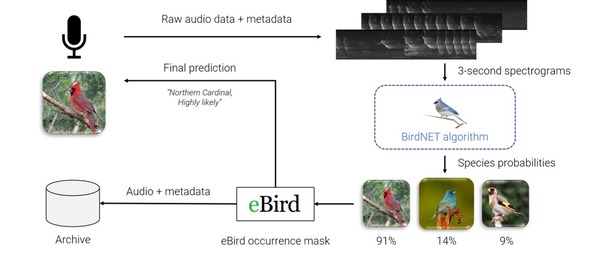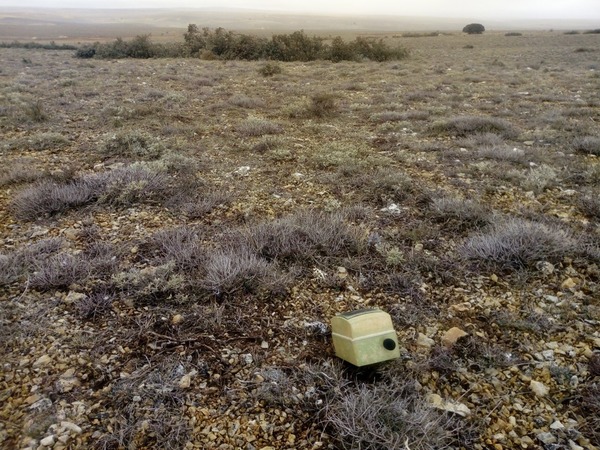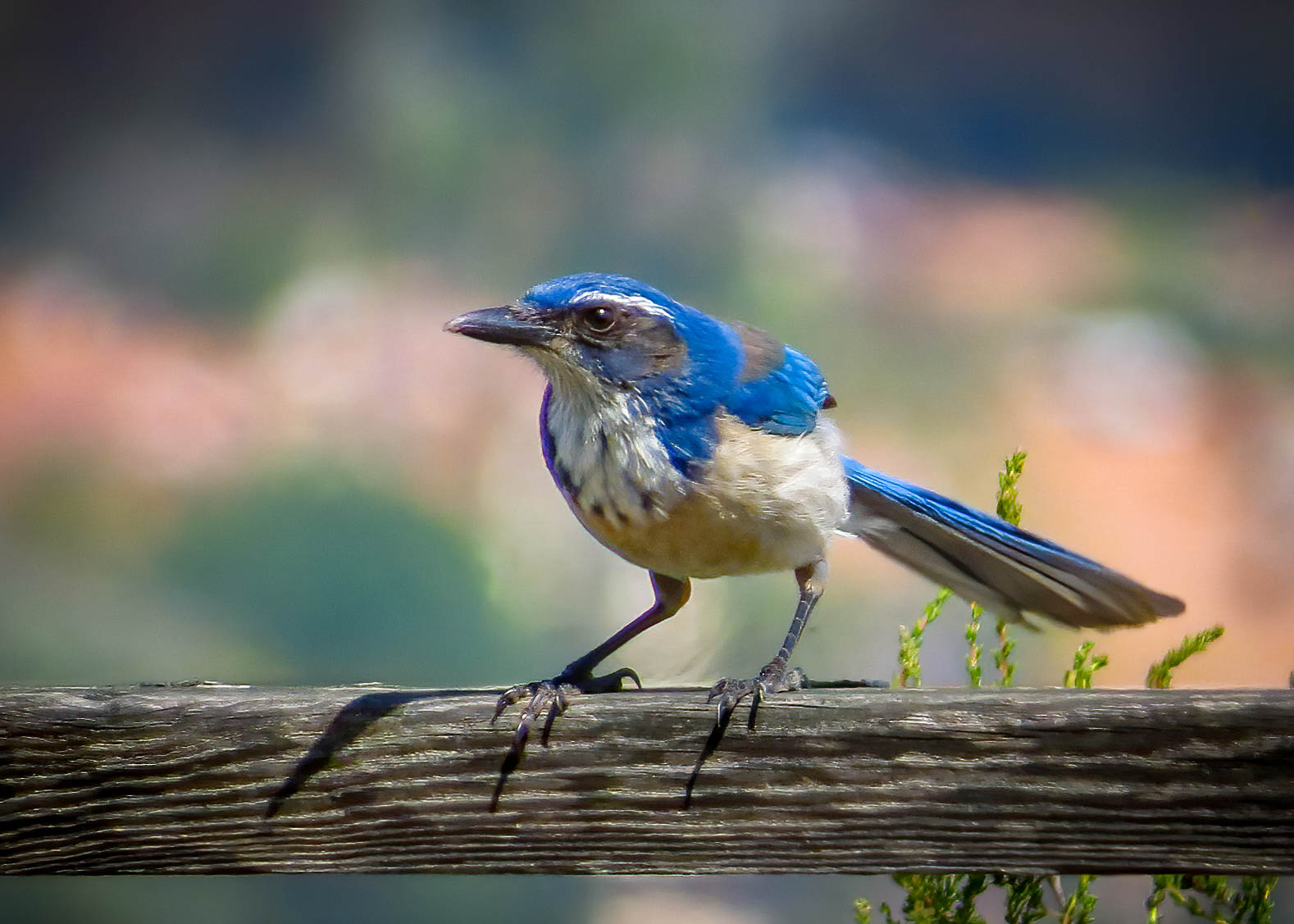 LINKED PAPER
LINKED PAPER
BirdNET: applications, performance, pitfalls and future opportunities. Pérez-Granados, C. 2023 Ibis. doi: 10.1111/ibi.13193 VIEW
Recently, several novel technologies have revolutionised the way researchers and ornithologists monitor birds, including plenty of online platforms and mobile applications that allow citizen science. Among these online platforms, there are several online sound libraries, mainly uploaded by enthusiastic citizens who record birds during their spare time. So, what if we use all these labelled recordings to create algorithms, based on machine learning, able to identify bird sounds? The idea is simple; we could use hundreds of recordings of the same species to create a species-specific algorithm able to recognise that vocalisation in future recordings.
There are a few available options for automated bird sound identification, such as BirdNET. BirdNET has rapidly become a common bird identification software employed by both the scientific community (e.g., Manzano-Rubio et al. 2022) and the public, with over 1.1 million participants using the BirdNET App during 2020 (Wood et al. 2022). BirdNET was created as a joint effort between the Cornell Lab of Ornithology and the Chemnitz University of Technology (Kahl et al. 2021). BirdNET is a free – ready to use – classifier that uses convolutional neural network algorithms to identify wildlife vocalisations in small segments (3 seconds) from longer audio recordings. The updated version of BirdNET is able to identify over 3,000 bird species from around the world (Wood et al. 2022). In a few words, BirdNET can be used to record audio on a smartphone, upload recordings onto a web-based platform or run the BirdNET-Analyzer (downloadable from GitHub), and provides a bird identification along with a confidence score, which ranges from 0 to 1 (Figure 1). Scores closer to 1 meaning greater confidence that the clip contains a sound of the target species. BirdNET allows the user to apply a filter for period or location of recording, or to look for a defined set of species aiming to reduce the number of mislabelled detections.

Figure 1 Work scheme of BirdNET. Audio recordings are analysed in three second clips and provide an output of species probabilities © Cornell Lab of Ornithology (original source https://birdnet.cornell.edu/).
Personally, I have been working on passive acoustic monitoring of birds for several years and faced issues when developing my own species recogniser. However, during the spring of 2022 I became aware of how easy and fast it was to use BirdNET to analyse thousands of recordings. I was also aware of a few studies assessing the use of this technique for bird monitoring. Therefore, in August 2022 I aimed to review the scientific evidence about the applications, performance and pros and cons of BirdNET. Currently, most scientific studies have used BirdNET to obtain a list of the species within an area, identify vocalisations challenging to a human, or for methodological purposes. However, few studies have used BirdNET as part of real-world monitoring schemes. Moreover, all published studies have been carried out in Europe or North America, which is explained by the fact that until the latest update most of the included species were from the Northern Hemisphere. The continued refinement of BirdNET, including new updates and other improvements will likely extend its use under real monitoring programmes in the near future. It would be also desirable to evaluate the utility of BirdNET in estimating bird densities from sound recordings (Pérez-Granados and Traba 2021), which might be difficult but may extend its use far beyond species detection.

Figure 2. Passive acoustic monitoring is a trending technique that requires the deployment of programmed sound recorders in the field followed by recording interpretation, which can be done using BirdNET. In the picture there is a recorder aimed at detecting the presence of the Dupont’s Lark (Chersophilus duponti) © Cristian Pérez-Granados.
One of the most important and assessed parameters of BirdNET is the confidence score. The parameter ranges from 0 to 1 and can be considered as an index of the probability of correctly labelling a bird vocalisation, with values closer to 1 having a greater probability of being identified correctly. This is a user-selected parameter that can be used to filter – as a threshold – BirdNET outputs. The impact of this parameter on BirdNET outputs is variable among species but is largely consistent. The use of high confidence score thresholds increases the percentage of detections correctly classified but lowers the proportion of calls detected and bird species suggested, while the opposite is true when choosing a low confidence score. The selection of an optimal score may depend on the priorities of the user and research goals, but a minimum value of 0.5 would be a good starting point from where to assess the performance of BirdNET, and modify it accordingly to research goals and expectations.
Most of the studies assessed BirdNET precision, that is to say its ability to correctly identify bird vocalisations. BirdNET precision ranged around 72–85%, which one can consider as high. However, fewer studies assessed the ability of BirdNET to extract a large amount of bird vocalisations, scientifically defined as the recall rate (% target species vocalisations detected). Recall rate of BirdNET ranged around 33–84%. It should be paramount for any study aiming to use BirdNET to validate its performance, since variations in the recording conditions (e.g., species richness in the recording area, microphone quality and hour of recording) may have a large impact on BirdNET performance. Not validating BirdNET outputs could hamper the interpretation of the obtained results and provide poorly informed decisions.
BirdNET is in its infancy, but several scientific studies and ornithologists are already using this software. The main advantage is that the algorithms are already ready-to-use (see Manzano et al. 2022) and its ability to generate labels for multiple species at once, which could generate new scientific data and increase public awareness about bird conservation and capture public attention (see Wood et al. 2022). This potential has created great optimism within the ornithological community but we should be cautious about its use and I really hope that this blog and the linked paper may encourage some of you to use it. But please, do not forget to assess its performance!
References
Kahl, S., Wood, C. M., Eibl, M., & Klinck, H. 2021. BirdNET: A deep learning solution for avian diversity monitoring. Ecological Informatics 101236. VIEW
Manzano-Rubio, R., Bota, G., Brotons, L., Soto-Largo, E., & Pérez-Granados, C. 2022. Low-cost open-source recorders and ready-to-use machine learning approaches provide effective monitoring of threatened species. Ecological Informatics 101910. VIEW
Pérez‐Granados, C., & Traba, J. 2021. Estimating bird density using passive acoustic monitoring: a review of methods and suggestions for further research. Ibis 765-783. VIEW
Wood, C. M., Kahl, S., Rahaman, A., & Klinck, H. 2022. The machine learning–powered BirdNET App reduces barriers to global bird research by enabling citizen science participation. PLoS Biology e3001670. VIEW
Image credit
Top right: California Scrub-Jay © Wayne S. Grazio CC BY NC ND 2.0 Flickr.
If you want to write about your research in #theBOUblog, then please see here.





